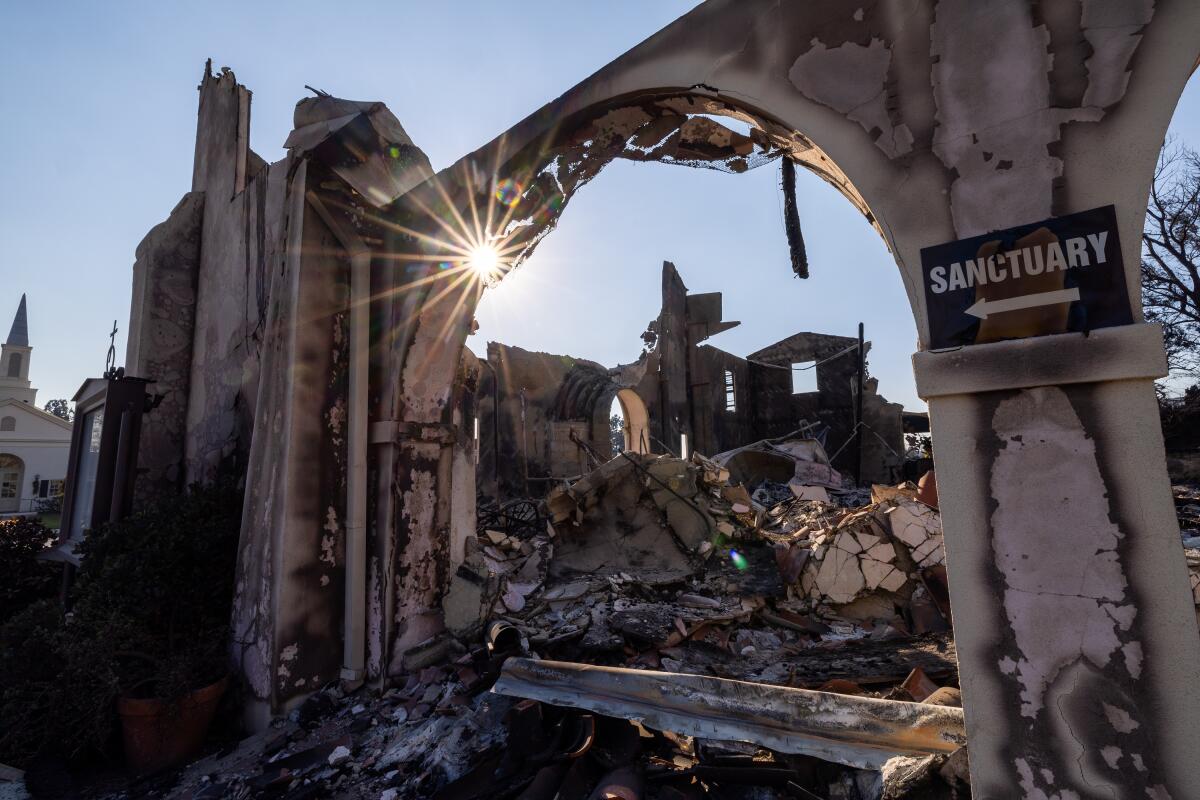L.A. fire risks are raised again this week. Here’s what to know

- Share via
Good morning. Here’s what you need to know to start your Monday.
- All about L.A.’s firestorms as the risk continues this week.
- Power lines? Old embers? Arson? Investigators, experts and amateurs look for the cause of the L.A. fires.
- In the ruins of his family home lost to the Palisades fire, a Times reporter confronts his elusive childhood in Malibu.
- And here’s today’s e-newspaper.
Sign up for Essential California
The most important California stories and recommendations in your inbox every morning.
You may occasionally receive promotional content from the Los Angeles Times.
Recovery efforts begin with another week of fire weather on tap
The threat from firestorms continues in Los Angeles County even as some families begin to sift through the smoldering remains of their homes this time last week. The scope of devastation from the pair of major wildfires still burning in the Santa Monica and San Gabriel mountains is becoming clearer as the region’s long road to recovery begins to take shape.
Twenty-four people had been confirmed dead from the blazes and 16 others reported missing as of Sunday night. With more than 12,000 structures damaged or destroyed, it’s likely the wildfires will be dubbed the most destructive in U.S. history.

As of Monday morning, the Palisades fire had burned more than 23,700 acres and was 13% contained. The Eaton fire had scorched over 14,000 acres and was 27% contained. Tens of thousands of homes and other structures are still threatened.
While recovery efforts begin, even as the fires continue to burn and threaten the region, here are three things to know about L.A. County’s wildfire disaster and the response so far.
The fires — and new ones — could flare up
Firefighters made progress against both blazes over the weekend but are now bracing for another round of strong winds.
The National Weather Service issued a new red flag warning for much of L.A. and Ventura counties through Wednesday due to “damaging winds with extremely critical fire weather conditions.”
Forecasters say gusts could hit 55 and 70 mph in some areas from early Tuesday morning through Wednesday morning.

“The very dry vegetation combined with the prolonged extreme fire weather conditions will support rapid spread and erratic behavior of any new or existing fires,” the agency warned.
Officials added that “a brief break” in the extreme conditions could come by Friday, “with significantly increased humidity and lighter winds with a 20% chance of very light rain next weekend.”
Recovery efforts will be complicated — and that’s even before politics get involved
How will local, state and federal officials meet the incredible need facing tens of thousands of wildfire victims? As past disaster events in and out of state demonstrate, it won’t be easy.
“There are the immediate questions, like where people who have lost their homes will stay tonight, tomorrow and the rest of this week,” Times reporter Kevin Rector wrote this weekend. “And the longer-term ones, such as whether L.A. should rebuild in areas that remain vulnerable to the increasing cruelty of climate change.”
The hard work of clearing debris, including toxic materials, will follow. And for the many displaced residents, finding shelter and affordable housing will be a vital, arduous process. Already, concerns are setting in that the massive rebuilding effort needed could favor more affluent homeowners and their mansions at the expense of middle-class families who lost more modest homes.
Another big question: How will politics — especially as the soon-to-be-sworn-in President Trump reshapes the federal government — affect the recovery process?
On Thursday, President Biden vowed that the U.S. government would cover 100% of the state’s disaster assistance costs for the next 180 days. But Trump has a history of ideological clashes with California and in the past threatened to withhold fire disaster aid to the state unless Gov. Gavin Newsom aligned with him on water policies.

Beware misinformation and partisan distortion
In the anxious rush for information during a major crisis, misleading or downright false information can spread quickly. And in the era of generative AI, so can fabricated images, like one of the Hollywood sign burning that took off shortly after news of the Sunset fire broke out Wednesday evening.
Experts say misinformation or disinformation like this can lead to real-world harm.
Times reporter Karen Garcia spoke with experts to understand how we can all avoid getting fooled and spreading inaccurate information to others.
One tip they shared: Question the source of posts you’re seeing in your feeds.
“Check who the author/owner of the post and social media account is,” Karen wrote. “You should also cross-reference the posted information with what local and state government officials, first responders, disaster relief agencies, known nonprofit organizations and trusted media outlets are saying on their official websites. If it’s a charitable organization, you can verify its legitimacy by checking with tools Charity Navigator and GuideStar.”
And a friendly reminder: TV commentators are not paid to provide a public service. They are paid to provide a point of view, regardless of the facts being gathered by the scores of reporters working to provide information and context that help us all understand how a tragedy of this magnitude unfolded.
It’s understandable that many are drawn to a simple explanation for why these fires started or why they burned out of control. That gives us something or someone to direct our frustration toward.
There’s really no effort or evidence needed to lob blame at a river restoration project happening at the opposite end of our massive state or local agencies’ DEI policies.
But it takes time, experience covering fires (as many in The Times’ newsroom have) and a willingness to seek insights from experts in order to better understand the multilayered missteps, environmental conditions and climate realities that took L.A. County down this path of mass destruction. That nuance is not conducive to reactionary, stunted TV personalities with partisan agendas.
More coverage of the L.A. wildfires

Investigating fires’ origins
- Power lines? Old embers? Arson? Investigators, experts and amateurs look for the cause of the L.A. fires.
- Questions swirl about what — or who — started the Palisades fire near a beloved hiking trail.
- Investigators are studying an Eaton Canyon electrical tower area as the possible origin site of the Altadena fire.
- Officials are investigating whether Southern California Edison equipment ignited the Hurst fire.
Loss, recovery and resiliency
- The L.A. fire victims: Who they were.
- First, they lost their home insurance. Then, L.A. fires consumed their homes.
- In “a mass erasure of heritage,” numerous historic landmarks have been lost in L.A.
- A hang-gliding pioneer tried to save his Topanga home. His friends never heard from him again.
- Gov. Gavin Newsom says President-elect Donald Trump has not responded to his invitation to tour damage in the fire-ravaged state.
- Newsom suspended landmark environmental laws to ease rebuilding in the wildfire zones.
- They lost their Altadena church in the Eaton fire. They still gathered to worship.
- Gustavo Arellano: How L.A. County Supervisor Kathryn Barger plans to help Altadena rebuild.
- Nearly all of the LAUSD will reopen on Monday. Several Eaton fire-area districts remain closed.
Firefighting and public safety
- As the wildfires rage, private firefighters join the fight for the fortunate few.
- Those include private contractors in place to help Rick Caruso’s home and neighborhood.
- Burglary suspects dressed as firefighters were arrested in an L.A. fire zone, officials say.
Look for the helpers
- As fires rage, day laborers volunteer to clean up Pasadena’s streets.
- With food, supplies or just hugs, volunteers show fire victims they’re not alone.
- Explore opportunities to volunteer across the region (though some may be weekend only).
- How you can help the incarcerated firefighters battling L.A.’s wildfires.
- Here’s a list of free and discounted resources for victims of the Los Angeles-area fires.
How to protect yourself from wildfire impacts
- Should pregnant people evacuate L.A. to escape the smoke?
- Here’s how to care for your eyes, sinuses and skin during a wildfire.
- How to make a DIY air filter.
Get unlimited access to the Los Angeles Times. Subscribe here.
Commentary and opinions
- Carla Hall: Wildfires come with the wildness that draws us to Los Angeles.
- Robin Abcarian: The L.A. fires will eventually be extinguished. The terrible loss will remain.
- Jackie Calmes: Merrick Garland’s integrity saved the Department of Justice, only to doom it again.
- Guest opinion: The San Gabriel Valley is where Asian immigrants go to never assimilate. I embrace that legacy.
This morning’s must reads

In the ruins of his family home lost to the Palisades fire, Times reporter James Rainey confronts his elusive childhood in Malibu. “When I walked away from the old house Thursday morning, I finally had a good little cry,” he wrote. “Not for the tired old place that had seen better days. But mostly for my parents, who had worked so hard for so many years to create a refuge from the hurly-burly of the outside world.”
How can we make this newsletter more useful? Send comments to [email protected].
For your downtime

Staying in
- 🥣 Here’s a recipe for chickpea and escarole soup with crispy bread crumbs.
- ✏️ Get our free daily crossword puzzle, sudoku, word search and arcade games.
And finally ... your photo of the day
Show us your favorite place in California! Send us photos you have taken of spots in California that are special — natural or human-made — and tell us why they’re important to you.

Today’s great photo is from Jamo Jackson of Perris: a poppy-rich view from Gavilan Hills, east of Lake Elsinore in Riverside County in 2019.
Have a great day, from the Essential California team
Ryan Fonseca, reporter
Amy Hubbard, deputy editor, Fast Break
Check our top stories, topics and the latest articles on latimes.com.
Sign up for Essential California
The most important California stories and recommendations in your inbox every morning.
You may occasionally receive promotional content from the Los Angeles Times.




